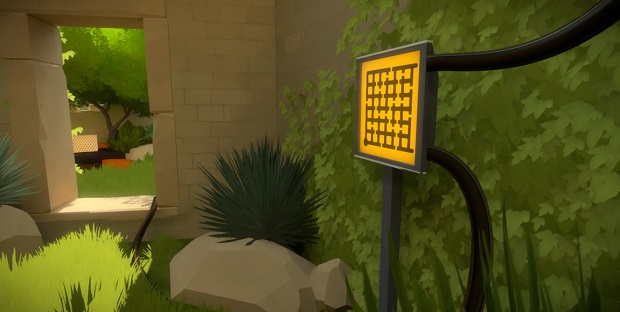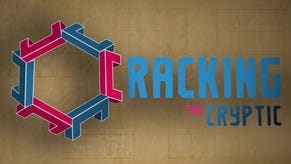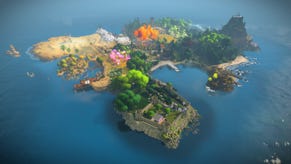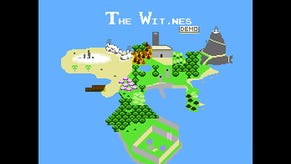How Does The Witness Teach Without Words?
"I had a picture of how it would work and how people would play it"
This is The Mechanic, where Alex Wiltshire invites a developer to help him put their game up on blocks and take a wrench to hack out its best feature, just to see how it works.
The Witness [official site] is generally considered to be very hard. It is frequently very hard! I’m feeling a little brutalised by a succession of puzzles that I encountered last night. But I’m not sure it’s particularly hard compared to all puzzle games. Sokobond, Pullblox and Box Boy on Nintendo 3DS, Spacechem, The Talos Principle: I find all good puzzle games hard.
But in The Witness you feel peculiarly alone. Everything you know about the game you’ve learned yourself from observation and experimentation, a feature that doesn’t make The Witness unique, but combined with its sheer wordlessness, it makes its puzzles feel awfully cold when you’re stumped. And yet answers do come, because the game is always subtly teaching you, a lesson that starts right at the game’s beginning, in the Entry Yard, where you experience its:
THE MECHANIC: Non-verbal tutorial
“Some games will stop you and make sure you’ve got something or take control of the camera and point it at things. I don’t like any of that stuff,” Jonathan Blow tells me, didactic as ever. But he’s right, eh? There’s nothing quite like feeling you’ve solved puzzles completely by yourself, and that you’re a natural part of a game world. These are two qualities of The Witness that are established right in the Entry Yard.
It’s a small area, but it achieves a lot. It starts in a tunnel, with a puzzle panel at its end. This opens a door into a small cave with another panel, which opens a door up some stairs and into a sunny courtyard of grass, ruined walls, colourful flowers and more panels. A forcefield over the yard’s gate prevents you exiting.
The Entry Yard tells you a remarkable amount about the game over the short time you spend in it. You learn how to move around, the fundamentals of its maze puzzles and how to interact with them, and start getting enveloped in its world. It’s all about showing you what The Witness is about, and also what it’s not about. It makes you understand that you should pay attention to your surroundings, and also the game’s limits: there are no items to put in inventories or to combine with others.
Take the first puzzle you see once you get outside. It’s directly opposite the exit to the tunnel, so you can’t miss it, and once solved, it lights up a cable that goes off snaking through the grass. Follow it and you reach another panel, and solving that leads you to the gate – and now you have a core idea of how many of the puzzles are interconnected.
The gate’s panel isn’t usable, but you can follow two unlit cables back into the yard. Things are getting more complex. One goes to another panel, but another disappears over a wall. Track around the building and you’ll find it leading into another panel, but this one has two solutions, and the one you’ll probably go for first is the wrong one. So now you have the idea that panels can control things, and there might be multiple solutions, each with different effects. “That doesn’t really come into play until way later in the game, but we prompt it right there,” says Blow.
So that’s the evident functional layer to the yard. But there’s more going on. Rewind back to emerging from the tunnel, and look forward and over the wall, and you see the mountain in the background. “Even if people don’t notice it consciously, they might subliminally notice that things on the island are very carefully arranged if this is already happening in their first minute of the game, and that this careful positioning may come into play in other places on the island.”
And – minor spoiler alert, so miss out this paragraph if you’d rather avoid it – there’s yet another thing. From that same view, on the path to the panel, is one of the environmental puzzles. It’s utterly brazen. “It’s almost magician stagecraft misdirection, right?” says Blow. “You’re not paying attention to it, you’re paying attention to the panel. If you were looking at the clouds in your first playthrough, you’d probably notice it’s really weird, but people don’t. That’s not actually the first one, though.” Consciously or not, you’re probably sensing that there’s a lot packed into these spaces.
Remarkably, Blow says that designing the introduction to the maze puzzles themselves was fairly straightforward. “They’re not that sophisticated or subtle really.” The first three are based on having you trace a maze that you don’t need to figure out, presented with rising levels of complexity. The broad strokes of the sequence was set way back in 2010, when Blow decided privately show The Witness at PAX. “There was a blobby landscape with some puzzle panels on it. It wasn’t a game, really, per se.” So in the two days before the show, he designed a sequence of panels to ease players in. “I had a picture of how that would work and how people would play it, and when we put it out there, it was a successful design and just worked.”
There was therefore little iteration of this gentle succession that silently – other than the one-off appearances of button prompts – introduce adults and children alike to the fundamentals of what you’ll be doing for the rest of the game. Blow isn’t exactly shy to toot his own horn, so he’s surely not being disingenuous in saying they’re not sophisticated, and they’re simple in form, but the way they prompt you to fill in the gaps yourself somehow feels far grander.
The rest of the yard, however, was continually iterated upon. When I first played it back in 2011, it looked completely different, from the buildings to its location on the island, and it moved around plenty of times after then. The part of the puzzle setup that had the most iteration was a detail that you probably never thought about: the way the cable leading from the gate disappears over the wall. “People thought that it was leaving the area,” says Blow. “Changing it was just a subtle difference in the way the cable curves as it disappears out of sight.” Players were getting confused – which is a very different issue to being stuck. “I didn’t want them to be confused at all; it was iterated on most perhaps because it’s the most subtle thing.”
The yard isn’t only about teaching obvious practicals. It’s also establishing an aesthetic and mood. For such a stylised game, The Witness is extraordinarily grounded in physical reason: there’s always a bolt to fix a panel to its fitting, a support for every structure. Thekla’s use of architects during development was about ensuring buildings and spaces made physical sense. “Even simple things: there’s a pretty high castle wall, so what kind of castle is it? What era is it from? What is the construction like? In the turrets at the corners, even though you can’t go up them any more, there would’ve been a way up, a wooden stairway, so where do we put the evidence of where the posts were driven into the wall?” The yard’s buildings, many of which are in ruins, were fully planned out as a complete building.
All this detail would lead to a lot of visual noise, but the art design focuses your attention on what matters. Take that puzzle panel that sits opposite you when you emerge from the tunnel. Behind it is a sandstone wall, which in most games would be slathered in a high definition, bump mapped, texture, but you don’t see its lines until you’re close. As a result, the panel effortlessly and silently stands out. The simplicity of the texturing also gives visual space for The Witness’ global illumination – the subtle, beautiful way coloured light reflects from things like flowers on to the surfaces around them.
But having the detail wasn’t just about coherence. The Witness really asks you to examine your surroundings. “The thing about a design like that is that it’s very precarious, because you’re inviting people to look very closely at all these 3D models and notice all the dumb problems that a lot of games sweep under the rug.” The back side of everything has to look good as its front, and things need to make sense. “If you have a building with a roof on it, and that roof isn’t supported, you’re just going to see this floating roof, and you’re like, well I’m noticing that this place isn’t real.
“And also, if you’re calling people’s attention to this level of detail, there has to be something there to feed the mind. Forget even whether it’s realistic or not. When you provide that, it’s not necessarily a conscious reaction, but the player’s mind notices and it goes in and is part of the experience.”
That’s all in the Entry Yard. A small space, a simple one. And yet convoluted, too, with depths you might not be trained to see until much later. It’s a mark of what’s to come, and it delineates everything that The Witness is and isn’t. But what it somehow manages not to impart – to its credit – is that really, you’re far from alone. This is one of the most designed spaces ever made, trampled over and over by Blow and the rest of his team for the seven years of its development. Every tiniest detail has been pored over, made ready for your gaze. You might understand it’s this contrived, and yet it’s still utterly quiet.














